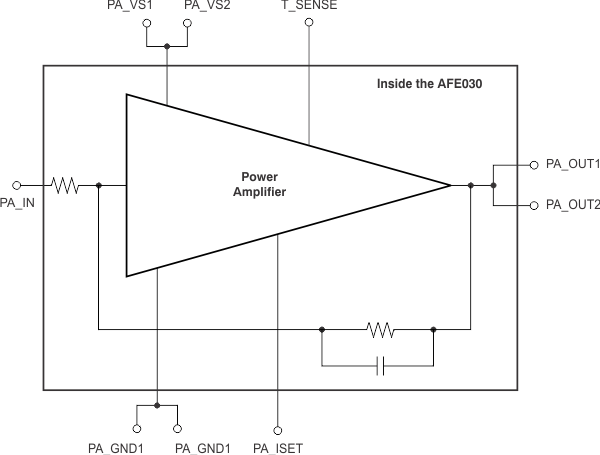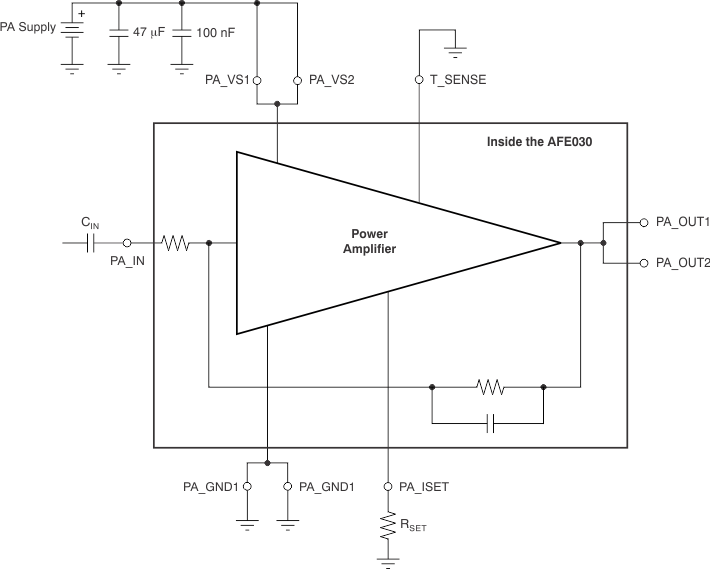JAJSHJ6B December 2011 – June 2019 AFE030
PRODUCTION DATA.
- 1 特長
- 2 アプリケーション
- 3 概要
- 4 改訂履歴
- 5 概要 (続き)
- 6 Pin Configuration and Functions
-
7 Specifications
- 7.1 Absolute Maximum Ratings
- 7.2 ESD Ratings
- 7.3 Thermal Information
- 7.4 Electrical Characteristics: Transmitter (Tx), Tx_DAC
- 7.5 Electrical Characteristics: Transmitter (Tx), Tx_PGA
- 7.6 Electrical Characteristics: Transmitter (Tx), Tx_FILTER
- 7.7 Electrical Characteristics: Power Amplifier (PA)
- 7.8 Electrical Characteristics: Receiver (Rx), Rx PGA1
- 7.9 Electrical Characteristics: Receiver (Rx), Rx Filter
- 7.10 Electrical Characteristics: Receiver (Rx), Rx PGA2
- 7.11 Electrical Characteristics: Digital
- 7.12 Electrical Characteristics: Two-Wire Interface
- 7.13 Electrical Characteristics: Zero-Crossing Detector
- 7.14 Electrical Characteristics: Internal Bias Generator
- 7.15 Electrical Characteristics: Power Supply
- 7.16 Typical Characteristics
- 8 Parameter Measurement Information
- 9 Detailed Description
- 10Application and Implementation
- 11デバイスおよびドキュメントのサポート
パッケージ・オプション
メカニカル・データ(パッケージ|ピン)
- RGZ|48
サーマルパッド・メカニカル・データ
- RGZ|48
発注情報
9.3.1 PA Block
Figure 24 shows a typical powerline communications application system diagram. Table 2 is a complete list of the sections within the AFE030.
 Figure 24. Typical Powerline Communications System Diagram
Figure 24. Typical Powerline Communications System Diagram Table 2. Block Descriptions
| BLOCK | DESCRIPTION |
|---|---|
| PA | The PA block includes the power amplifier and associated pedestal biasing circuitry |
| Tx | The Tx block includes the Tx_Filter and the Tx_PGA |
| Rx | The Rx block includes the Rx PGA1, the Rx Filter, and the Rx PGA2 |
| ERx | The ER block includes the two-wire receiver |
| ETx | The ER block includes the two-wire transmitter |
| DAC | The DAC block includes a digital-to-analog converter |
| ZC | The ZC block includes both zero crossing detectors |
| REF1 | The REF1 block includes the internal bias generator for the PA block |
| REF2 | The REF2 block includes the internal bias generators for the Tx, Rx, ERx, and ETx blocks |
The power amplifier (PA) block consists of a high slew rate, high-voltage, and high-current operational amplifier. The PA is configured with an inverting gain of 6.5 V/V, has a low-pass filter response, and maintains excellent linearity and low distortion. The PA is specified to operate from 7 V to 26 V and can deliver up to ±1 A of continuous output current over the specified junction temperature range of –40°C to +125°C. Figure 25 illustrates the PA block.
 Figure 25. PA Block Equivalent Circuit
Figure 25. PA Block Equivalent Circuit Connecting the PA in a typical PLC application requires only two additional components: an ac coupling capacitor, CIN, and the current limit programming resistor, RSET. Figure 26 shows the typical connections to the PA block.
 Figure 26. Typical Connections to the PA
Figure 26. Typical Connections to the PA The external capacitor, CIN, introduces a single-pole, high-pass characteristic to the PA transfer function; combined with the inherent low-pass transfer function, this characteristic results in a passband response. The value of the high-pass cutoff frequency is determined by CIN reacting with the input resistance of the PA circuit, and can be found from Equation 1:

Where:
- CIN = external input capacitor
- fHP = desired high-pass cutoff frequency
For example, setting CIN to 3.3 nF results in a high-pass cutoff frequency of 2.4 kHz. The voltage rating for CIN should be determined to withstand operation up to the PA power-supply voltage.
When the transmitter is not in use, the output can be disabled and placed into a high-impedance state by writing a '0' to the PA-OUT bit in the Enable2 Register. Additional power savings can be realized by shutting down the PA when not in use. Shutting down the PA for power savings is accomplished by writing a '0' to the PA bit in the Enable1 Register. Shutting down the PA also results in the PA output entering a high-impedance state. When the PA shuts down, it consumes only 2 mW of power.
The PA_ISET pin (pin 46) provides a resistor-programmable output current limit for the PA block. Equation 2 determines the value of the external RSET resistor attached to this pin.

Where:
- RSET = the value of the external resistor connected between pin 46 and ground.
- ILIM = the value of the desired current limit for the PA.
Note that to ensure proper design margin with respect to manufacturing and temperature variations, a 30% increase in the value used in Equation 2 for ILIM over the nominal value of ILIM is recommended. See Figure 16, PA Current Limit vs RSET. For maximum output current, PA_ISET (pin 46) may be connected directly to ground.